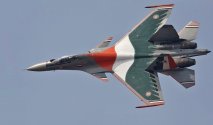Already surpassed 2 decades of running and still anticipated to continue its services for at least the next ten years, the Sukhoi Su-30MKI “Flanker-H” has allowed the Indian Air Force to flaunt its capability to possess air superiority along with performing a wide range of missions in domains of air-to-ground combat. The heavyweight combat platform is derived from the classic Su-27 and optimized as per the requirements specified by New Delhi that will meet the criteria essential to suitably fit the IAF operational requirements. As of April 2022, 261 airframes are officially in service and spread across 12 combat squadrons, 1 combat training school (TACDE), and 1 flight and system test center (ASTE).
This abundance can be further glorified when comparatively analyzed vis-à-vis the Pakistan Air Force inventory, which
possesses 221 fourth-generation fighters (75 F-16ADF/AM/BM/C/D; 134 JF-17A/B; 5 J-10CE).
Among the salient features of the aircraft, is the diverse nature of sub-systems carried within the Russian-designed airframe. The integration of components from multiple manufacturers, that are France, Israel, and India, has allowed the organization to get the best from the world and combine them to achieve the desired objective.
This abundance can be further glorified when comparatively analyzed vis-à-vis the Pakistan Air Force inventory, which
possesses 221 fourth-generation fighters (75 F-16ADF/AM/BM/C/D; 134 JF-17A/B; 5 J-10CE).
Among the salient features of the aircraft, is the diverse nature of sub-systems carried within the Russian-designed airframe. The integration of components from multiple manufacturers, that are France, Israel, and India, has allowed the organization to get the best from the world and combine them to achieve the desired objective.


